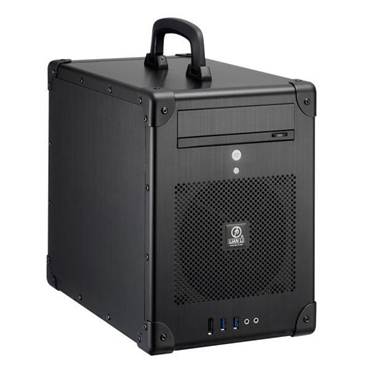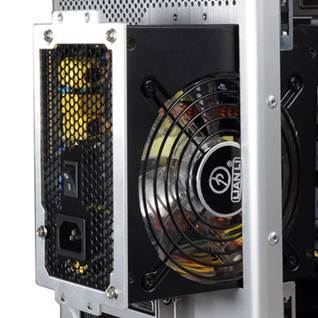Gorgeous and well-built, but hot and
expensive as well
Lian Li was one of the first manufacturers
to produce mini-ITX cases as part of its core I product line, matching its
legendary aluminum construction and build quality with the emerging mini form
factor. One of its latest cases, the Adventurer-branded PC-TU200, has a basic
appearance that matches Lian Li's long-serving PC-Q08, with a sleek flight-case
look and improved rigidity to match.

Lian
Li PC-TU200
Made almost entirely from aluminum, the
TU200 is extremely light at just 3.49kg. Lian Li has also reinforced each
corner with machined aluminum guards, which are riveted into place around the
core chassis to reinforce and protect the case during transit. Adding credo to
its Adventurer tag is the plastic carry handle on the case's roof, enabling you
to easily grab the case ready to cart off to a LAN party.
Meanwhile, side-panel and roof venting is
conspicuous by its absence, with a large vented area at the front case allowing
airflow into the single 140mm intake fan. There's also a ventilated section in
the base to provide airflow to the floor-mounted graphics card, but only the
front vent is fitted with a dust filter, and if it requires cleaning, you'll
need to remove the fan.
Elsewhere on the case's front fascia is a
pre- stealthier 5.25in drive bay, a common inclusion with Lian Li's cases, and
a touch that makes a case look much more complete and stylish than a bare drive
face plate. Meanwhile, a front panel with a pair of USB 3 ports, an eSATA port,
and 3.5mm microphone and headphone jacks is located at the bottom of the case's
front, while combination power/power LED and reset/hard drive LED buttons sit
in the middle of the front fascia.
With the reinforced aluminum plates around
the case's corners and along its length, there's no immediately obvious way to
remove the recessed side panels. This is achieved via a pair of levers at the
rear of the case, secured with thumbscrews that pry the left and right panels
out of tool-free clips inside the case. It's a slick process, enabling the
case's sides to appear smooth and free of any fittings, although you'll need to
pull the panels free once the levers pop a corner out.

Lian
Li even includes a rubber-capped graphics card holder to negate board-bend on
longer cards.
Inside the case, the motherboard is fitted
to a motherboard tray, rather than directly to the side panel as with the
PC-Q08, with a four-drive 3.5in hot-swap drive cage on storage duty. The drive
cage is fully removable, but it's cleverly placed so that a graphics card,
mounted along the case's floor, can fit beneath it without having to compromise
on storage space. Lian Li even includes a rubber-capped graphics card holder to
negate board-bend on longer cards.
However, the hot-swap bays, while kitted
out with excellent vibration- dampening mounts for 3.5in drives, don't quite
fit 2.5in drives. As they don't reach the hot-swap connectors, you'll need to
connect these to their cables yourself; an annoying task that requires some
serious finger dexterity to work around the existing hotswap fittings.
Meanwhile, there's space for a PSU with a
maximum depth of 140mm, which you mount by sliding it into the back of the case
and fitting it over the top of the motherboard, although Lian Li seems
ambiguous about which way around the PSU should be mounted. Its own website
shows images of the PSU with its fan mounted towards the side panel, while the
manual indicates it should be fitted with the fan towards the motherboard.
Regardless, there's just enough room for airflow on either side. Fitting the
PSU can be tricky, though, as the mount means the majority of cables will only
be introduced at the final fit, making it difficult to route cables out of the
way inside.
With a PSU mounted directly above the
motherboard, CPU cooler headroom is limited to just 80mm too, but this is still
enough for stock coolers or low-profile aftermarket coolers, such as our test
system's Zalman CNPS8900.

Due to the cabling constraints of adding
the PSU last, however, building a PC inside the TU200 was a little troublesome
and when we'd finished, cooling ability wasn't stellar. With its single 140mm
intake fan, theTU200 managed a CPU delta T of 49°C - the hottest of any case on
test, while its GPU delta T of 58°C was also on the warm side, although
perfectly stable. The front cooling fan's noise proved slightly intrusive too
and, with no additional fan mounts, there's no way to improve the situation
either.
Conclusion
While the Lian Li PC-TU200 certainly looks
the part, decked out in gorgeous brushed aluminium, it's tricky to build
inside, and it offers poor cooling thanks to its lack of fan mounts and
venting. What's more, at $210, it costs more than double the price of the
BitFenix Prodigy; despite its aluminium charms, the TU200 is a poor choice for
those looking to build a full- spec rig in a mini-ITX case.
Pros and cons
Ford: Great build
quality; very light; pre-fitted handle
Labeouf: Poor
all-round cooling; no extra fan mounts; expensive; hotswap bays don't fit 2.5in drives
How much?
Price: $211.5 inc
VAT
Scores
Cooling: 21/30
Features: 11/20
Design: 25/30
Value: 11/20
Overall: 68%
|